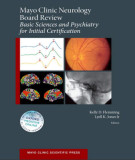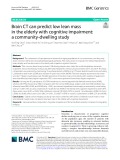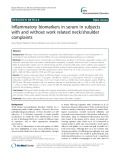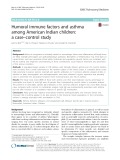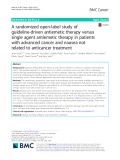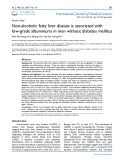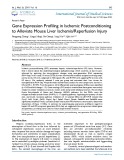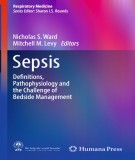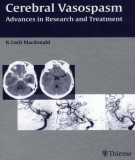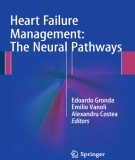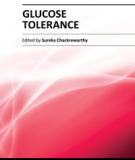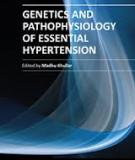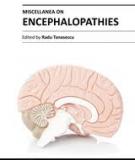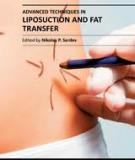
Pathophysiological pathways
-
Part 1 book "Mayo clinic neurology board review - Basic sciences and psychiatry for initial certification" includes content: Cerebrovascular anatomy and pathophysiology; meninges and ventricles; afferent system overview; peripheral and central pain pathways and pathophysiology; special somatic sensory afferent overview; peripheral nerve, neuromuscular junction, and muscle anatomy; spinal cord anatomy,... and other contents.
 235p
235p  muasambanhan07
muasambanhan07
 20-02-2024
20-02-2024
 5
5
 0
0
 Download
Download
-
Ebook "Metabolism of human diseases: Organ physiology and pathophysiology" examines the physiology of key organs (e.g. brain, eye, lung, heart, blood vessels, blood, immune system, gastrointestinal tract, pancreas, liver, fat tissue, kidney, reproductive system, teeth, bone and joints) and how defective metabolism and signaling pathways within these organs contribute to common human diseases. The book also describes commonly used drugs and explains their molecular targets.
 382p
382p  tukhongthienlac
tukhongthienlac
 24-06-2023
24-06-2023
 11
11
 3
3
 Download
Download
-
The coexistence of sarcopenia and dementia in aging populations is not uncommon, and they may share common risk factors and pathophysiological pathways. This study aimed to evaluate the relationship between brain atrophy and low lean mass in the elderly with impaired cognitive function.
 13p
13p  vinobelprisen
vinobelprisen
 26-03-2022
26-03-2022
 17
17
 5
5
 Download
Download
-
Cumulating evidence from rodent models points to a pathophysiological role of inflammatory signaling in the epileptic brain with Toll-like receptor-4 signaling acting as one key factor. However, there is an apparent lack of information about expression alterations affecting this pathway in canine patients with epilepsy.
 14p
14p  vigalileogalilei
vigalileogalilei
 28-02-2022
28-02-2022
 13
13
 1
1
 Download
Download
-
Autism spectrum disorder (ASD) is a common neurodevelopmental disorder that tends to co-occur with other diseases, including asthma, inflammatory bowel disease, infections, cerebral palsy, dilated cardiomyopathy, muscular dystrophy, and schizophrenia. However, the molecular basis of this co-occurrence, and whether it is due to a shared component that influences both pathophysiology and environmental triggering of illness, has not been elucidated.
 19p
19p  viaristotle
viaristotle
 29-01-2022
29-01-2022
 32
32
 0
0
 Download
Download
-
Endogenous α-synuclein (α-Syn) is involved in many pathophysiological processes in the secondary injury stage after acute spinal cord injury (SCI), and the mechanism governing these functions has not been thoroughly elucidated to date.
 18p
18p  viansan2711
viansan2711
 30-07-2021
30-07-2021
 9
9
 1
1
 Download
Download
-
Although it has recently been recognised that inflammation is important in the development of work-related musculoskeletal disorders (MSDs), the exact pathophysiological pathways are unknown.
 7p
7p  viannito2711
viannito2711
 20-04-2021
20-04-2021
 10
10
 1
1
 Download
Download
-
Asthma is recognized as intimately related to immunologic factors and inflammation, although there are likely multiple phenotypes and pathophysiologic pathways. Biomarkers of inflammation may shed light on causal factors and have potential clinical utility.
 7p
7p  vimaine2711
vimaine2711
 26-03-2021
26-03-2021
 5
5
 1
1
 Download
Download
-
The metabolic syndrome refers to the co-occurrence of or clustering of several known cardiovascular risk factors, including insulin resistance, abdominal adiposity, atherogenic dyslipidemia and endothelial dysfunction. These conditions are interrelated and share underlying mechanisms and pathways. It identifies a subgroup of patients with shared pathophysiology who are at high risk of developing cardiovascular disease, hypertension and type II diabetes.
 6p
6p  trinhthamhodang9
trinhthamhodang9
 16-12-2020
16-12-2020
 12
12
 2
2
 Download
Download
-
Nausea/vomiting (N/V) not related to anti-cancer treatment is common in patients with advanced cancer. The standard approach to management is to define a dominant cause, and treat with an antiemetic selected through pathophysiologic knowledge of emetic pathways.
 9p
9p  vibaku2711
vibaku2711
 22-07-2020
22-07-2020
 8
8
 1
1
 Download
Download
-
Non-alcoholic fatty liver disease (NAFLD) is associated with the dysregulation of multiple metabolic and inflammatory pathways. These can lead to extrahepatic disorders involving the kidney, a vulnerable organ responsible for extra-renal complications. Evaluating the association between NAFLD and low-grade albuminuria as a renal complication would be helpful to better understand the pathophysiology and extra-hepatic complications of NAFLD.
 7p
7p  vinasaki2711
vinasaki2711
 12-11-2019
12-11-2019
 14
14
 0
0
 Download
Download
-
Ischemic postconditioning (IPO) attenuates hepatic ischemia/reperfusion (I/R) injury. However, little is known about the underlying biological pathophysiology, which could be, at least in part, informed by exploring the transcriptomic changes using next-generation RNA sequencing (RNA-Seq).
 12p
12p  vinasaki2711
vinasaki2711
 12-11-2019
12-11-2019
 12
12
 0
0
 Download
Download
-
(BQ) Part 1 of the document Definitions, pathophysiology of sepsis and the challenges of bedside management has contents: Introduction, sepsis definitions, epidemiology of sepsis - current data and predictions for the future, overview of the molecular pathways and mediators of sepsis,... and other contents. Invite you to refer.
 145p
145p  thuongdanguyetan05
thuongdanguyetan05
 05-07-2019
05-07-2019
 12
12
 0
0
 Download
Download
-
(bq) part 1 book “cerebral vasospasm - advances in research and treatment” has contents: molecular mechanisms of vasospasm, remodeling and inflammation, experimental—endothelium, experimental—pathophysiology.
 181p
181p  tieu_vu15
tieu_vu15
 07-09-2018
07-09-2018
 15
15
 2
2
 Download
Download
-
(BQ) Continued part 1, part 2 of the document Heart failure management the neural pathways presents the following contents: The autonomic cardiorenal crosstalk - pathophysiology and implications for heart failure management, barorefl ex activation therapy in heart failure, renal refl exes and denervation in heart failure, back to the future,...
 85p
85p  thangnamvoiva4
thangnamvoiva4
 01-07-2016
01-07-2016
 44
44
 3
3
 Download
Download
-
The progression from normal glucose tolerance (NGT) to type 2 diabetes involves intermediate stages of impaired fasting glucose (IFG) and impaired glucose tolerance (IGT), also known as prediabetes. The pathophysiology underlying the development of these glucose metabolic alterations is multifactorial, leading to an alteration in the balance between insulin sensitivity and insulin secretion. Our knowledge of the molecular basis of the signaling pathways mediating the various physiologic effects of insulin is steadily advancing....
 254p
254p  crius75
crius75
 02-01-2013
02-01-2013
 74
74
 6
6
 Download
Download
-
Although this book is far from being exhaustive, it conveys some of the novel ideas and directions in the membrane trafficking field through a combination of review, research, and technical articles. The book is organized in a series of chapters that will “transport” the reader from the endoplasmic reticulum, where proteins and lipids are synthesized, to the plasma membrane, where molecules are either delivered or internalized via endocytosis.
 246p
246p  yeutinh98
yeutinh98
 22-09-2012
22-09-2012
 76
76
 5
5
 Download
Download
-
The second section of the book collects studies on pathophysiology of ischemic damage. This is an area where our knowledge has greatly advanced in the past decade, mainly due to the study of novel pathways of damage and of novel techniques to investigate them. Better knowledge of how brain tissue becomes damaged in stroke will hopefully lay the foundation for better therapies, be them recanalization (like thrombolysis) or neuroprotection (like hypothermia).
 214p
214p  yeutinh98
yeutinh98
 19-09-2012
19-09-2012
 82
82
 6
6
 Download
Download
-
Considerable recent detail is provided on cytokines and signalling mechanisms which translate immune events into cellular pathology including prostaglandins (Andrey Sorokin), endoplasmic reticulum (Reiko Inagi), mTOR receptors (Lena Succar et al.), STAT3 signalling pathways (Fumio Tsuji et al.), TGF-ß (Hyun Soon Lee) and extracellular signal-regulated kinases (Maki Urushihara et al.). Animal models (Elena Goiman et al., Chia-Chao Wu et al., María Ángeles Jiménez et al.) and end results such as urinary biomarkers (Sophie Ohlsson) are updated as well....
 240p
240p  kmkmkmkmkm
kmkmkmkmkm
 08-09-2012
08-09-2012
 66
66
 3
3
 Download
Download
-
Pain transmission and modulatory pathways. A. Transmission system for nociceptive messages. Noxious stimuli activate the sensitive peripheral ending of the primary afferent nociceptor by the process of transduction. The message is then transmitted over the peripheral nerve to the spinal cord, where it synapses with cells of origin of the major ascending pain pathway, the spinothalamic tract. The message is relayed in the thalamus to the anterior cingulate (C), frontal insular (F), and somatosensory cortex (SS). B. Painmodulation network.
 5p
5p  ongxaemnumber1
ongxaemnumber1
 26-11-2010
26-11-2010
 73
73
 3
3
 Download
Download
CHỦ ĐỀ BẠN MUỐN TÌM








